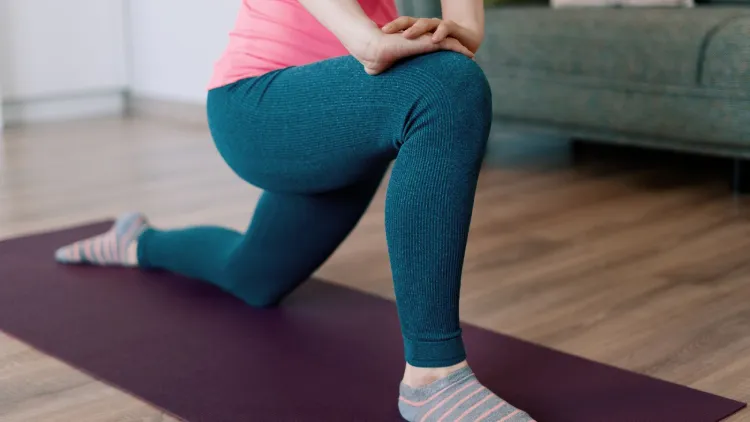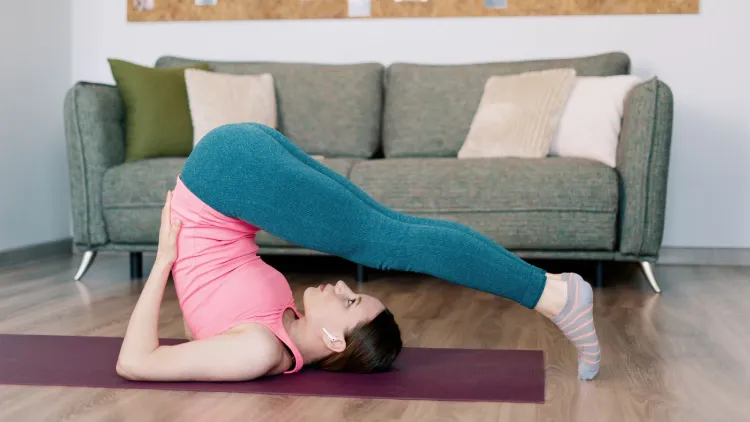Sciatica, which is a painful disorder of the sciatic nerve, might severely interfere with routine activities because of the lower back pain, numbness, tingling, and leg weakness. It can be aggravated by a herniated disc, spinal stenosis or poor muscle balance like piriformis syndrome that can prove painful and exasperating. The good news is that stretching exercises for sciatica offer a safe, natural way of dealing with such symptoms and their alleviation.
This guide tells you all you could want to know about stretching to relieve sciatica, including the background of the causes and symptoms, as well as the best stretches in terms of relief of the condition. You will also come to know about the benefits of stretching, which include lessening the compression of nerves, attaining flexibility, and greater circulation.
We will also take you through the step-by-step methods, give you safety tips on ensuring that it works best, and when to consult the doctor. Both in the case of acquiring quick relief and in the case of avoiding the occurrence of flare-ups in the future, these stretching exercises for sciatica can be very helpful in the process of healing your spine condition and restoring its functionality in your case.

What is Sciatica?
It is possible to note that sciatica is not a health condition; it is a symptom of a disease that has a problem with the sciatic nerve. It usually starts at the buttocks or the lower back and spreads to exist on one of the legs. Severe instances of this problem even result in the incapacitation of the leg or the foot of the affected side.
Common causes of sciatica include:
- Herniated disc: pressure on the sciatic nerve roots might be caused by a slipped or ruptured disc.
- Spinal Stenosis: The spinal canal becomes slender, and this squeezes the nerves.
- Piriformis syndrome: It occurs when the piriformis muscle, deep in the buttocks, irritates the nerve.
- Degenerative disc disease: The effect of wear and tear on spinal discs affects nerve functioning.
- Spondylolisthesis: A vertebra moves forward in front of the other and causes pinching of nerves.
Symptoms typically involve:
- Burning or piercing pain in the sciatic nerve
- Pins and needles or numbness in the bottom, legs or feet
- Weakness of the lower extremities, cheeks
- Enhanced sitting, sneezing or getting up problems
It is imperative to understand these symptoms to select the right choice of stretching exercises for sciatica, since each stretch helps to work on different muscles that are the cause.

Benefits of Stretching for Sciatica
Stretching exercises for sciatica offer many benefits, and in particular, those that are conducted regularly, but also in the appropriate way.
1. Decreases Compression of the Nerves
Pressure on the sciatic nerve can be alleviated by stretches that target such tight muscles as the piriformis and the hamstrings. Fewer pressures signify less suffering.
2. Enhances Flexibility and Mobility
Stiff muscles limit your body’s movement, and this increases pain. Flexibility due to regular stretching translates to less strain and freedom of movement of the body.
3. Enhances Circulation
Increased blood circulation with stretching also feeds tissues and helps them promote faster recovery in inflamed parts due to blood circulation that helps to expel the inflammation and toxins.
4. Facilitates Long Lasting Healing
Stretching regularly would, in the long term, assist in the causes that trigger sciatica, like poor posture or muscle imbalances. Scientists conducted studies to find out how sciatica stretch physical activities could be used as a preventative and therapeutic course.
5. Encourages Body Positioning
The cause of sciatica is poor posture. Stretching makes the spine and pelvis align with each other, and less pressure is imposed on the sciatic nerve over a long time.
To conclude, it is stated that stretching exercises for sciatica are more than instant relief, as they help the spine remain healthy and functional in the long term.

Best Stretching Exercises for Sciatica
The other three stretching exercises for sciatica involve major muscles which tend to compress or touch the sciatic nerve. Such stretches are smooth, good, and applicable to any fitness level.
1. Piriformis Stretch
Piriformis muscle extends between the lower back spine and the upper part of the thigh bone, and when tight, may push directly against the sciatic nerve.
How can it be done?
- Lie on your back with both knees bent.
- Using two feet, place the right ankle across the left knee in a figure four.
- Catch your left thigh and draw it towards the chest.
- When holding this position, you are supposed to experience the stretch of your right buttock.
- Rest 20 -30 seconds, do both sides.
It is one of the most important stretching exercises in case of sciatica, allegedly caused by piriformis syndrome.
2. Knee to Chest Stretch
This easy exercise relieves the tension in the glute muscles and the lower back muscles.
The way to do it:
- Lie down, face upwards, with the legs stretched out.
- Lift your right leg in an upward motion to bring it near the chest, and leave your other leg straight.
- Apply pressure on your lower back onto the floor.
- Do 20 -30 seconds and alternate legs.
Incorporating it into your everyday life, you can get rid of discomfort dramatically and even increase mobility.
3. Seated Spinal Pignin
It is one yoga pose that loosens the compression on the spine, the hips and shoulders.
The way to do it:
- Get on the floor, one leg stretched out.
- Your right leg should cross your left in such a way that your right foot rests on your left thigh.
- Lay your right hand back to support and your left elbow outward on the right knee.
- Twist a little to the right, turning the head with it.
- Rest 20-30 seconds and repeat the same on the other side.
This variation aids in counteracting the narrowness in the lower back and the spinal muscles, which are at times known to cause the pain experienced during sciatica.
4. Child’s Pose
It is a soothing posture that releases the hips and the lower back.
The way it can be done:
- Get on the floor on your knees and rest your heels.
- Straighten out your arms and bring your torso spine down to the ground.
- Put your forehead on the mat and breathe.
- Follow this pose for 30 seconds to 1 minute.
This also has even easier ways of incorporating the stretch into your routine, and it brings relief, which is subtle and effective.
5. Cat-Cow Stretch
This stretch helps to create flexibility in the spine and straightens the vertebrae, hence putting less pressure on the nerves.
The way it can be done:
- Begin in all fours with your hands under the shoulders and knees under the hips.
- Draw the air and straighten your back (cow pose). Stretch your head and your tailbone.
- Inhale and arch your back (cow pose), tip your chin down and tuck your pelvis.
- Continue the movement 1-2 minutes with smooth, steady movements.
This stretch makes the spine flexible and healthy as part of your routine.
6. Hamstring Stretch
Those who have tight hamstrings may jerk the pelvis and irritate the sciatic nerve.
The way it can be done:
- Kneel on the ground, one leg stretched out.
- Bend the second leg and rest your foot at the inside of your thigh.
- Touch your toes with your straight leg without arching your back.
- 20-30 sec and change leg, repeat.
This exercise elongates the muscles at the back of the thigh and also prevents strain at the lower back.

Tips for Safe Stretching
It is important to follow the best practices of your stretching exercises to prevent sciatica injury and pain.
- Warm Up First: A short stroll, or gentle aerobic exercise, is used to warm the muscles.
- Move smoothly: do not struggle to get a stretch. Sorrow is a call to release.
- Breathe Deeply: Relaxing by breathing aid you loosen up with every stretch.
- Avoid the Bounce: Stretches are held without bouncing, which gives muscles a chance to grow longer.
- Be Consistent: Set a target to stretch every day or at least three times and five times a week.
- Pay Attention to Your Body: Everyone is flexible and can tolerate more pain than others.
When performed in the right manner, focusing stretches can have a wondrous effect on the quality of life you are living.
When to See a Doctor
Even though stretching may be very useful, certain cases of sciatica need to be treated by medical personnel. You should reach an ailment professional when you have:
- Puppy experiences sudden and intense pain which is not getting better
- Unaffected Sensations: Foot or leg weakness or Numbness
- Blasting of bowel or bladder control
- No change during a couple of weeks of stretching
- Post-traumatic and post-fall symptoms
Depending on the judgment of a doctor, imaging tests, physical therapy, medications, or even surgeries can be advised. Exercise. Usually, sciatica stretching exercises are included as a prolonged sciatica treatment.

Final Thoughts
A natural, natural, and very workable view of stretching exercises for sciatica is to deal with pain in the sciatic nerve. The stretches target the muscles involved in sciatic nerve compression and eliminate the tension, improve flexibility, and aid in healing. Whether to recover after a flare-up or avoid subsequent episodes, it is possible to start to integrate these exercises into everyday life and feel a long-term benefit.
It is all about consistency. Short-term help is good, but change comes with a long-term commitment. Stretching is always to be combined with a healthy style of life when posture is kept in equilibrium and balanced, ergonomics are applied, and sport exercises are performed regularly.
Movement can be very effective when you are faced with sciatica. Have a start with these mild stretching exercises for sciatica, heed your body, and own your pain today.
Frequently Asked Questions
How frequently should the stretching of sciatica be performed?
For optimum success, you are advised to do stretching exercises for sciatica at least three or 5 times per week. Stretching every day is even better, so long as your body permits it. Regularity ensures the enhancement of flexibility, elimination of nerve pressure, and avoidance of recurrent flares.
Do the exercises to stretch sciatica pain, or aggravate the pain?
The stretching should never be accompanied by sharp pain. If you experience bad symptoms after the workout, stop and seek medical attention. The slow, gentle stretches are recommended and safe, but any forcing, over-stretching of the movements may cause a transfer of the pain to the sciatic nerve.
Do stretching exercises treat sciatica permanently?
Stretching exercises for sciatica do not cure the patient, but it is an excellent long-term management option. They act as pain relievers, they decrease inflammation, and they make one flexible. Stretching will provide the best effect when it is used in combination with the correction of the posture, ergonomic setting and healthy lifestyle.
What is the most appropriate stretch in the case of sciatica due to the piriformis syndrome?
Piriformis Stretch is among the best sciatica stretches that occur when the piriformis is the causative agent. It focuses on the deep buttock muscle, which usually pressesurizes the sciatic nerve, thereby alleviating the pressure and enhancing free movement.







